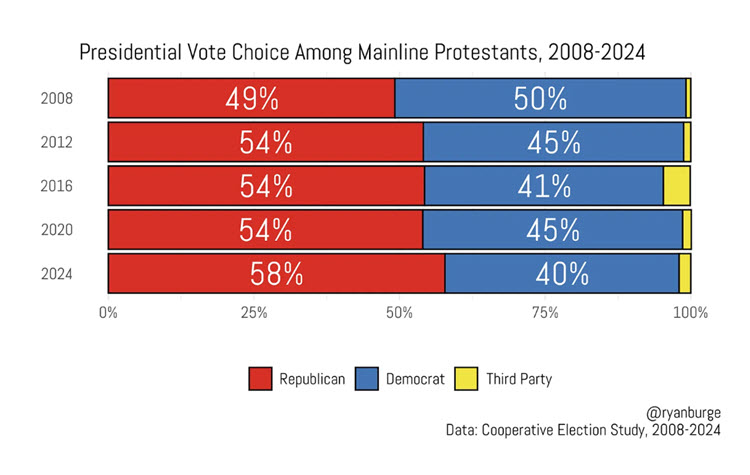I’ve been a Mainline Protestant my entire life. Over the course of my adult years I’ve been involved with shepherding 10 local congregations affiliated with four of this traditions’ seven denominations.
Liberal Clergy
I’m well aware that clergy tend to be considerably more progressive than their parishioners, especially in Mainline Protestantism. In recent years this reality was explored most thoroughly by the Public Religion Research Institute. In 2022 and 2023 their research involving more than 3,000 Mainline Protestant Pastors found that these clergy are “far more liberal than their congregants on a host of political and social issues.”
Reflecting on this then new data, in 2023 I wrote, “Mainline clergy are more likely to identify as a Democrat than as Republican while their parishioners are more likely to identify as Republican. In rank order, denominations with the greatest percentage of clergy identifying as Democrat: Episcopal Church and Christian Church (Disciples of Christ) – 60%, United Church of Christ – 71%, and Presbyterian Church (USA) – 61%.”
Less Liberal Members
For the last few days every time I scroll through social media I see people commenting on or resharing an image Ryan Burge published earlier this week that shows a steady increase in the percentage of Mainline Protestant churchgoers who voted Republican in US Presidential elections from 2008 to 2024.

More specifically, this timeline begins with a near perfect split among those voting Republican (49%) and Democrat (50%) in 2008. Then, in 2012, 2016, and 2020 the percentage voting Republican increased to and remained at 54%. In 2024, it increased yet again climbing to 58%.
Over a 16 year period the percentage of Mainline Protestant Churchgoers who voted for the Democrat dropped from 50% to 40% while the percentage who voted for the Republican rose from 49% to 58%.
Outliers
Burge goes on to breakdown the Mainline voting trends by exploring changes over this timeline among each of its seven denominations.
Ranked by percentage growth in those voting Republican they are
- Evangelical Lutheran Church in America: +3%
- Episcopal: +5%
- Christian Church (Disciples of Christ): +5%
- United Methodist: +7%
- Presbyterian Church (USA): +9%
- American Baptists: +14%
- United Church of Christ: +17%
Ranked by percentage voting Republican in the 2024 election they are
- Episcopal: 40%
- American Baptists: 48%
- United Church of Christ: 51%
- Christian Church (Disciples of Christ): 51%
- Evangelical Lutheran Church in America: 53%
- Presbyterian Church (USA): 57%
- United Methodist: 62%
Put differently, majorities in five of the seven denominations voted for the Republican candidate for President in the most recent election.
So What?
Burge isn’t alone in observing that the so-called liberal Mainline Protestant tradition isn’t actually liberal (just more liberal than Evangelical Protestants). He has, however, done a masterful job of explaining this reality by visualizing data about recent Presidential elections. And, he provides a summary statement that every person who is a part of or who has interest in Mainline Protestantism needs to know: “A lot of the major mainline denominations are about as purple as it gets in modern American politics.”
For Conversation
After reading this post, I encourage you to read Burge’s article: 2024 Election Post-Mortem: Mainline Protestants. If you’ve not already read what other commentators have added, I invite you to take a few minutes to read at least a couple of their reflections before engaging in conversation.
The following questions are intended for those within Mainline Protestantism
- Review the statistical change for your denomination from 2008 to 2024. What is your initial reaction to this data? How does knowing this inform the way you navigate conversations in your religious world?
- Consider your local congregation over the same time period. Engage in conversation with a few key leaders inviting them to share how they think your congregants have shifted over this time (aligned with the change in your denomination, moving in the opposite direction as the denomination, moving in the same direction as the denomination but more rapidly, etc.).
- Are clergy affiliated with your denomination and in your geographical area generally perceived as being more liberal than those in their congregations? If so, how does this show up in congregational life?
Further Reading
For more about shifts over time in Mainline Protestantism check out My Religion is Dying: A Deep Dive into Mainline Decline, which includes links to more than 50 blog posts I authored on the topic between 2009 and 2024.
I encourage you to follow Ryan Burge on your preferred social media platform(s). His shortform and longform writing has been mentioned numerous times on So What Faith and his book 20 Myths About Religion and Politics in America was named a Top 10 Book of 2022.